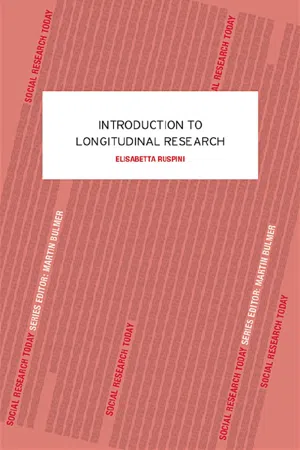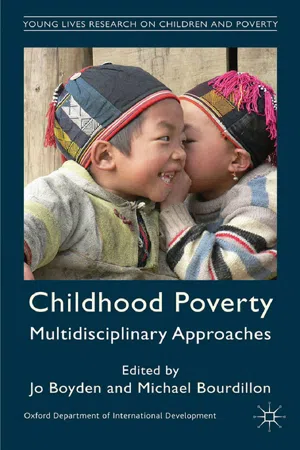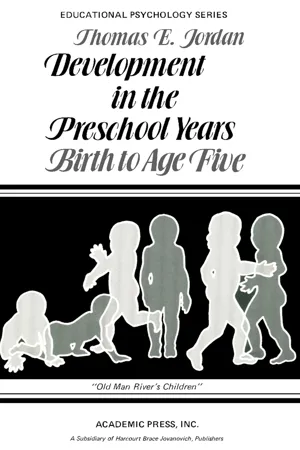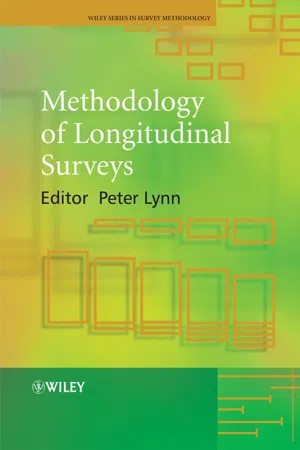Social Sciences
Longitudinal Study Sociology
A longitudinal study in sociology is a research method that involves collecting data from the same subjects over a period of time, often years or even decades. This approach allows sociologists to observe and analyze changes in individuals or groups, providing valuable insights into social behaviors, attitudes, and trends over time.
Written by Perlego with AI-assistance
Related key terms
1 of 5
11 Key excerpts on "Longitudinal Study Sociology"
- eBook - ePub
- Emily Gilbert(Author)
- 2023(Publication Date)
- SAGE Publications Ltd(Publisher)
1 What is longitudinal research?Overview of content
This chapter will provide you with the fundamental and basic information about longitudinal studies. It will answer the key question, ‘What is a longitudinal study?’ and then explain the advantages and disadvantages of using a longitudinal methodology to conduct research.Some of the advantages and disadvantages introduced in this chapter will be expanded on further in separate chapters in this book, and this is signposted where necessary.As well as a practical explanation of longitudinal studies, the chapter will also provide a short introduction to one of the major theoretical issues associated with longitudinal studies – developing a theory of change.Learning outcomes
After you have read this chapter, you will be able to:- understand what a longitudinal study is;
- describe the benefits of carrying out research using a longitudinal methodology;
- describe the drawbacks of longitudinal studies;
- understand what a theory of change is.
What is a longitudinal study?
At its most basic, alongitudinal studyis one that follows the same subjects over time, taking repeated measures from them. By taking repeated measurements over time, a longitudinal study is a method by which to study change. Longitudinal studies can last weeks, months or even years. By following the same subjects for so long, researchers can see how different things change or stay the same over time, such as attitudes, behaviours, health conditions, educational or career paths, or relationships and family structure. This stability or change can also be looked at in relation to past events or experiences, establishing how certain events and experiences can impact on various outcomes.The subjects followed by longitudinal studies are called ‘sampling units’. Sampling units are the single items that make up the population of interest. Thepopulation - eBook - ePub
Research Design
Succesful Designs for Social Economics Research
- Catherine Hakim(Author)
- 2012(Publication Date)
- Routledge(Publisher)
8 Longitudinal studies DOI: 10.4324/9780203354971-8 Regular surveys and longitudinal studies are the two designs that most explicitly focus on social change processes, but they do so in different and complementary ways. Regular surveys provide information on net change at the macro-level, while longitudinal studies provide information on the much larger volume of gross changes (or flows) at the microlevel (see Chapter 7). Longitudinal studies are often initiated when regular surveys or other sources reveal new trends that they cannot fully describe or explain (especially if they do not contain a panel element). The longitudinal study is unique in its ability to answer questions about causes and consequences and hence to provide a basis for substantiated explanatory theory. The prospective longitudinal study takes a single sample or group and follows it up, with repeated data collections, over a long period of time (see Figure 1). Strictly speaking, the term longitudinal study refers only to prospective studies. The retrospective study, which is quicker and cheaper, is considered below as a quasi-longitudinal design. Longitudinal studies cover a ‘long’ period of time, although what is considered a long period of observation depends on the subject-matter and context, and the issues addressed. Studies of people experiencing a spell of unemployment may continue for only one or two years, while studies of human growth and maturation may continue for 30 years or longer. Generally, there are numerous data collections in order to collect information on changes as they are happening - eBook - ePub
- Elisabetta Ruspini(Author)
- 2003(Publication Date)
- Routledge(Publisher)
Part I Longitudinal research
Passage contains an image
1 What is longitudinal research?
The term ‘longitudinal’ will be used here to describe what can be defined as the minimum common denominator of a family of those methods which tell us about change at the individual micro level (Zazzo, 1967; Menard, 1991). This family is the opposite of that described by the term ‘cross-sectional research’.‘Longitudinal’ is a rather imprecise term. Longitudinal data can be defined as data gathered during the observation of subjects on a number of variables over time. This definition implies the notion of repeated measurements (van der Kamp and Bijleveld, 1998). Basically, longitudinal data present information about what happened to a set of units (people, households, firms, etc.) across time. The participants in a typical longitudinal study are asked to provide information about their behaviour and attitudes regarding the issues of interest on a number of separate occasions in time (called the ‘waves’ of the study) (Taris, 2000). In contrast, cross-sectional data refer to the circumstances of respondents at one particular point in time (I shall expand on these points later). Thus, the term ‘longitudinal’ refers to a particular type of relationship between phenomena: the type which evolves over the course of time and is termed diachronic, the opposite of synchronic - eBook - ePub
Advances in Environmental Psychology (Volume 5)
Methods and Environmental Psychology
- Andrew Baum, Jerome E. Singer(Authors)
- 2020(Publication Date)
- Routledge(Publisher)
For our purposes, the crucial point about these differing figures is that they could have been found out (without unduly trusting people’s memories) only by questioning the same people repeatedly—that is, by a longitudinal (or panel) study rather than a cross-sectional one. A cross-sectional study could only have estimated the number of poor in the year of the study, giving no data (except based on fallible memory) on the number of persistently or occasionally poor. The difference is like that between a snapshot of a crowd where we can make some aggregate measure, such as the number of people present, and a motion picture in which we can see the aggregate size of the crowd at each moment and also follow the activities of individuals as they leave or enter the crowd over time. The implementation of such large-scale longitudinal studies gained impetus in the early 1960s (Kalachek, 1979).Advantages of Longitudinal Studies
The distinctive feature of a longitudinal study is that it permits an investigator to follow people (or other individual units of analysis, e.g., families, organizations) over time; this means that data on individual changes, rather than only aggregated movements, are available for analysis. Thus research can focus on process by asking “how” and “why” and often “for whom” such changes occur. For example, in studying life-cycle processes a panel study might address such a question as “Does early unemployment among teenagers and youth represent a transitory phase that many go through with no particular long-run adverse consequences, or does such a period of unemployment lower future earnings and/or increase the proportion of time in later life that an individual is unemployed?”Longitudinal surveys are also particularly useful for the collection of cross-sectional data, if the period of time one wishes to consider is not instantaneous. Hence the successive interviews in NCS and in the survey of pesticide use are useful for bounding victimizations within the 6-month reference period and pesticide acquisition/disposal within the 5-month reference period, respectively. Similarly, the longitudinal design for the National Medical Care Utilization and Expenditure Survey permits a full year’s worth of data to be accumulated for each family, so that families can be distributed according to utilization of healthcare facilities and their costs. - eBook - PDF
Childhood Poverty
Multidisciplinary Approaches
- Oxford Department of International Development, Michael Bourdillon, Jo Boyden, Oxford Department of International Development, Michael Bourdillon, Jo Boyden(Authors)
- 2011(Publication Date)
- Palgrave Macmillan(Publisher)
Part I Methodology 15 1 Doing Longitudinal Research: Opportunities and Challenges in a Study of Childhood Karen Brock and Caroline Knowles Young Lives has been introduced as a longitudinal study that follows two cohorts of children in poor communities in Ethiopia, India, Peru, and Vietnam as they grow into young adults. In this chapter, after pointing to the importance of longitudinal studies in the social sci- ences, we use the experience of designing and implementing Young Lives to reflect on some issues surrounding the process of such studies, and on the use of their findings to inform policy. The power, potential, and challenges of longitudinal research The power of longitudinal research lies in its capacity to illuminate patterns of change in the lives of selected groups of people. Making repeated, structured observations about the same group over time allow the exclusion of unobservable individual characteristics that do not change over time (for example, an adventurous personality with a ten- dency to take risks) and the identification of short- and long-term pat- terns of change. A classic example of this can be found in the British Doctors Study, a longitudinal study which surveyed 40,000 British doc- tors six times between 1957 and 2001, and found the first statistical proof that tobacco smoking increases the risk of lung cancer (Doll et al. 2004). In the social sciences, longitudinal research can be divided into repeated cross-sectional and cohort studies. The former sample a cross- section of the population and survey it at given points in time. The latter track a group of people (a ‘panel’) selected because they have 16 Karen Brock and Caroline Knowles experienced the same event – typically birth – during a specified time period. Studies of these types can provide a glimpse into both the life histories of the individuals who make up a segment of the population, and the broader patterns of change that make up the social landscape. - eBook - PDF
Development in the Preschool Years
Birth to Age Five
- Thomas E. Jordan, Allen J. Edwards(Authors)
- 2013(Publication Date)
- Academic Press(Publisher)
Longitudinal Studies 2 This chapter will present information about longitudinal studies, a do- main of research that has become popular once more. The resurgence of interest is recognition that longitudinal data provide a way to understand important aspects of human situations. For students of development the first important data set is the set of growth measures gathered on his son by M . Gueneau de Montbeillard. The measures began with the boy's birth on 11 April 1 7 5 9 , and ended on 11 November 1 7 7 6 , when the boy was 16 years and 7 months (16:7). The values are recorded in the pre-metric units pieds, pouces, and lignes (foot, thumb [inch], and cord). This interesting data set was not published by de Montbeillard, but is extant because it appears in Sonnini's (1799) edition of the works of his colleague, Georges le Clerc, Comte de Buffon. De Montbeillard had previously helped Berryat with his 1 7 5 4 edition of the early proceedings of the Academie Royale des Sciences. Today, longitudinal study exercises the minds of people in a variety o f fields. In addition to studies in child development, there are major inquiries in schizophrenia (Sartorius, Jablonsky, 6c Shapiro, 1 9 7 7 ; Mednick, Schul- singer, & Venables, 1 9 7 9 ) , occupational choice (Parnes, 1 9 7 5 ) , and educa- tion (Fetters, 1 9 7 5 ) . In the abstract this is not surprising, since data over time can lead to fascinating insights. Concretely, there are many practical problems, and the challenge to organizational skill can be enormous. In the past, people used samples that were selected in part because they seemed 7 8 2. LONGITUDINAL STUDIES easy, comparatively speaking, to study. For example, the Oakland-Berkeley studies used protestant, middle-class white families. With equal facility, investigators have chosen to drop certain kinds of children as objects of study (probands). - eBook - PDF
- John Goodwin(Author)
- 2012(Publication Date)
- SAGE Publications Ltd(Publisher)
For Cousins, documentary is an art form, which ‘directs reality’ yet is ‘responsive to events in the real world’, employing a ‘socio-aesthetic palette’ (Cousins, 2006: 46). Researching in ‘Real Time’ – Longitudinal Approaches Social research that follows the temporal rhythms of lived lives is also rare. Studies tend either to rely on retrospective accounts of the past (for example, life history approaches), or they seek to capture trends by repeating a survey with different groups of people. It is much less common for research to fol-low the same individuals or groups over extended periods. Those that exist fall into three main areas (although see Elliot et al., 2007, for a fuller dis-cussion). First, a body of work within anthropology that has involved a trad-ition of studying a single small community over the course of a whole career (in some cases such studies have become intergenerational as anthropolo-gists ‘pass the mantle’ to junior colleagues and research students). The import-ant associated methodological literature on ‘long-term field-work’ explores a range of practical, ethical and epistemological issues (Foster et al., 1979; Kemper and Peterson Royce, 2002). Second, longitudinal studies (the most well known and well established studies of which are quantitative) involving panels of individuals researched at regular intervals. 1 In the same way that the 7 Up series returned to its subjects over time, these longitudinal cohort studies involve a series of ‘sweeps’ where data is collected from the panel. The scale, complexity and connectivity of the resulting data sets mean that the project of analysis is infinite, and the archiving and sharing of such data sets McLeod and Thomson Qualitative Longitudinal Research 321 with a community of secondary analysts is a central element in realizing their potential and the investment made in them. - eBook - PDF
- Roger Wimmer, Joseph Dominick(Authors)
- 2013(Publication Date)
- Cengage Learning EMEA(Publisher)
Another form of longitudinal research, trend studies (in which different people are asked the same question at different points in time) began showing up in mass media research in the 1960s. One of the most publicized trend studies was the continuing survey of media credibility done by the Roper organi-zation. Trend studies by Gallup and Harris, among others, also gained prominence dur-ing this time. More recently, the notion of cohort analysis , a method of research developed by demographers, has become popular. Cohort analysis involves the study of specific popu-lations, usually all those born during a given period, as they change over time. Other significant developments in longitudinal research have taken place as more sophisti-cated techniques for analyzing longitudinal data were developed. More technical infor-mation about advanced computational strat-egies for longitudinal data is contained in Magnusson, Bergman, Rudinger, and Torestad (1991) and in Toon (2000). Chapter 8 Longitudinal Research 225 Copyright 2012 Cengage Learning. All Rights Reserved. May not be copied, scanned, or duplicated, in whole or in part. Due to electronic rights, some third party content may be suppressed from the eBook and/or eChapter(s). Editorial review has deemed that any suppressed content does not materially affect the overall learning experience. Cengage Learning reserves the right to remove additional content at any time if subsequent rights restrictions require it. Cross-lagged correlations are computed when information about two variables is gathered from the same sample at two different times. The correlations between variables at the same point in time are com-pared with the correlations at different points in time. Three other forms of analysis using advanced statistical techniques have had rel-evance in longitudinal studies: path analysis, log-linear models, and structural equations. Path analysis is used to chart directions in panel data. - eBook - PDF
Analyzing Social and Political Change
A Casebook of Methods
- Angela Dale, Richard B Davies, Angela Dale, Richard B Davies(Authors)
- 1994(Publication Date)
- SAGE Publications Ltd(Publisher)
2 From Cross-Sectional to Longitudinal Analysis Richard B. Davies Paradoxically, cross-sectional analysis provides the main focus of this chapter. This stems from our confident belief that most social scientists courageous enough to confront the complexities of longitudinal data analy- sis will have already accumulated some experience of cross-sectional analy- sis. Cross-sectional analysis is consequently a sensible starting point for developing the motivation required to tackle the generally unfamiliar and admittedly often difficult statistical problems presented by longitudinal data. In this context, a glib claim that longitudinal data analysis is important because it permits insights into the processes of change is inadequate and certainly fails to convince many social science researchers who are concerned with substantive rather than methodological challenges. Cross- sectional analyses, they may argue, are not necessarily uninformative about the dynamics of social change because historical information often collected in cross-sectional surveys is readily incorporated. Questions about place of residence one or more years earlier are common in popu- lation censuses and permit comparison between the characteristics of migrants and non-migrants; data on length of unemployment are usually obtained in cross-sectional surveys of the unemployed and may be used as an explanatory variable in studying attitudes, health, or motivation; and even just birth dates of children provide a demographic record which may be used in a cross-sectional study of the employment status of married women. To develop the necessary motivation, it is therefore appropriate to consider in more detail the limitations of cross-sectional analysis, and this is the first objective of this chapter. - eBook - PDF
Handbook of Longitudinal Research
Design, Measurement, and Analysis
- Scott Menard(Author)
- 2007(Publication Date)
- Academic Press(Publisher)
Total population designs can, in principle, be used for practically any type of longitudinal analysis, given a sufficient num-ber of cases and measurement periods. Other designs are more limited, and their appropri-ateness must be judged in the context of a par-ticular research problem. 3 Measurement issues in longitudinal research Longitudinal research is subject to all of the concerns about measurement that arise in cross-sectional research, plus some issues with particular relevance to longitudinal research. Put another way, longitudinal research has all of the problems of cross-sectional research, plus a few more. In the second section of this handbook, the focus is on those issues most specifically relevant to longitudinal research. Skipping ahead for a moment, in Chapter 9 Toon W. Taris discusses reliability issues in longitudinal research. Taris examines issues of distinguishing unreliability from true change, and raises (not for the last time in this volume) the issue of the reliability of change scores as measures of change. This is followed in Chapter 10 by Patterson’s discussion of one of the challenging issues in long-term longitudinal research on individual change, the possibility that it may be appropriate to operationalize the same concept in different ways across the life course. The issue here is that, on one hand, whenever we change the way we measure a concept in longitudinal research, if there appears to be a change, we cannot be certain whether the change results from change in the concept we are trying to measure, or change in the measurement of the concept. Yet for research on individuals over the life course, the 8 Handbook of Longitudinal Research same measurement at different stages of the life course may not be validly measuring the same concept because different measures are appro-priate at different ages. - eBook - PDF
- Peter Lynn(Author)
- 2009(Publication Date)
- Wiley(Publisher)
Some of these surveys are carried out only once every n years, where n may take a value like 5 or 10. But some do indeed take place every year and thus, over time, they in principle cover the entire population of persons who have experienced the particular school system or educational establishment that is being sampled. 1.3 STRENGTHS OF LONGITUDINAL SURVEYS Longitudinal surveys present a number of options, both for data collection and for analysis, that are either simply impossible with cross-sectional surveys or cannot be achieved in a satisfactorily accurate or reliable way. Often these features are key elements of the rationale for carrying out a longitudinal survey. However, it is important to distinguish between longitudinal surveys and longitudinal data . Longitudinal surveys are a source of longitudinal data, as the resultant data include items that refer to different points in time. But there are also other ways of obtaining longitudinal data, including diary methods and the use of retrospective recall within a single survey instrument. We briefly discuss here the strengths of longitudinal data, but our particular focus is on the strengths of longitudinal surveys. 1.3.1 Analysis Advantages It is of course artificial to separate analysis advantages of longitudinal surveys from data collection advantages, as the reason for collecting a certain type of data is in order to be able to carry out certain types of analyses. The key advantages of longitudinal data 4 METHODS FOR LONGITUDINAL SURVEYS (which in most cases can only be accurately or adequately collected by longitudinal surveys) are analytical: Analysis of gross change . Analysis of gross change is perhaps one of the most common objectives of longitudinal surveys. Repeated cross-sectional surveys can be used to estimate net change, for example change in the proportion of employees who reg-ularly cycle to work.
Index pages curate the most relevant extracts from our library of academic textbooks. They’ve been created using an in-house natural language model (NLM), each adding context and meaning to key research topics.










